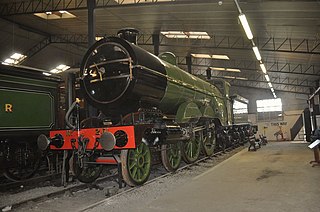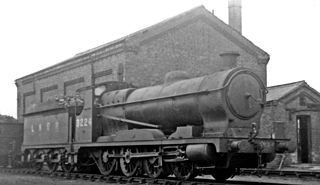
Sir Herbert Nigel Gresley was a British railway engineer. He was one of Britain's most famous steam locomotive engineers, who rose to become Chief Mechanical Engineer (CME) of the London and North Eastern Railway (LNER). He was the designer of some of the most famous steam locomotives in Britain, including the LNER Class A1 and LNER Class A4 4-6-2 Pacific engines. An A1 Pacific, Flying Scotsman, was the first steam locomotive officially recorded over 100 mph in passenger service, and an A4, number 4468 Mallard, still holds the record for being the fastest steam locomotive in the world (126 mph).
John George Robinson CBE, was an English railway engineer, and was chief mechanical engineer of the Great Central Railway from 1900 to 1922.
The London and North Eastern Railway (LNER) produced several classes of locomotive, mostly to the designs of Nigel Gresley, characterised by a three-cylinder layout with a parallel boiler and round-topped firebox. It produced the most famous locomotive of its day, 4468 'Mallard', the holder of the world steam locomotive speed record. It also built the world-famous 4472 'Flying Scotsman'. However, its locomotive inheritance was much greater than just the 'A4 Class', it also produced highly successful mixed-traffic and freight designs.

The GER Class C53 was a class of twelve 0-6-0T steam tram locomotives designed by James Holden for the Great Eastern Railway. They passed to the London and North Eastern Railway at the grouping, and received the LNER classification J70.

The Great Northern Railway (GNR) Class C1 is a type of 4-4-2 steam locomotive. One, ex GNR 251, survives in preservation. Much like their small boiler cousins, they were capable of reaching speeds of up to 90 mph (145 km/h). They were also known as Large Atlantics.

The Great Northern Railway (GNR) Class O2 was a class of three-cylinder 2-8-0 steam locomotives designed by Nigel Gresley for freight work and built by the GNR from 1921. Further examples were built by the London and North Eastern Railway (LNER) from 1924.

The North Eastern Railway (NER) Class H, classified as Class Y7 by the London and North Eastern Railway (LNER) is a class of 0-4-0T steam locomotives designed for shunting.

James Holden was an English locomotive engineer.

Stephen Dewar Holden was a British engineer, the son of the engineer James Holden and succeeded his father as locomotive superintendent of the Great Eastern Railway in 1908, a post he held until his retirement in 1912.

The GER Class T18 was a class of fifty 0-6-0T steam locomotives designed by James Holden for the Great Eastern Railway. They passed to the London and North Eastern Railway at the grouping in 1923 and received the LNER classification J66.
The GER Class E22 was a class of twenty 0-6-0T steam locomotives designed by James Holden for the Great Eastern Railway. They passed to the London and North Eastern Railway at the grouping in 1923 and received the LNER classification J65.

The first London and North Eastern Railway (LNER) Class A2 was a class of 4-6-2 steam locomotive designed by Vincent Raven for the North Eastern Railway. Two were built by the NER in 1922 before the grouping and another three by the LNER in 1924. Their LNER numbers were 2400–2404. All five locomotives were named by the LNER.

The GER Class R24 was a class of 0-6-0T steams designed by James Holden for the Great Eastern Railway (GER). They passed to the London and North Eastern Railway at the grouping in 1923 and received the LNER classification J67. Some R24s were rebuilt with higher boiler pressure in which form they were similar to the later Class S56. The rebuilt R24s, together with the S56s, were classified J69 by the LNER.

The Great Northern Railway Class H2 and H3 was a class of 2-6-0 steam locomotive designed for mixed-traffic work.

The Great Central Railway (GCR) Class 8A was a class of 0-8-0 steam locomotive built between 1902 and 1911 for handling heavy coal trains over the Pennines. They all passed to the LNER in 1923, who redesignated them Class Q4. They were withdrawn from service between 1934 and 1951.
The LNER Class J64 was a class of three 0-6-0T steam locomotives of the London and North Eastern Railway.

The GCR Class 5A was a class of seven 0-6-0T steams designed by John G. Robinson for work in docks operated by the Great Central Railway. They passed to the London and North Eastern Railway at the grouping in 1923 and received the LNER classification J63.

The Great Northern Railway (GNR) Class N1 was an 0-6-2T side tank steam locomotive designed by Henry Ivatt and introduced in 1906. They were all withdrawn from service between 1947 and 1959. None have survived.

The Great Northern Railway Class A1 1470 Great Northern was the first of 52 A1 class locomotives. It has also represented three distinct stages in the history of the British 4-6-2 "Pacific" steam locomotives designed by Nigel Gresley for the Great Northern Railway (GNR), a constituent company of the London and North Eastern Railway before the amalgamation of 1923, for which they became a standard design. Eventually Great Northern was completely rebuilt as Class A1/1.
















